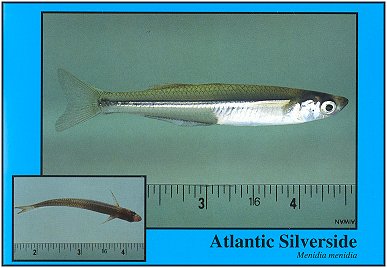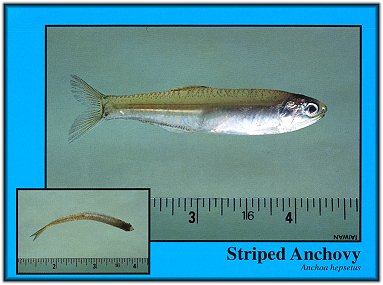After rummaging through countless fly pattern books, I realize how bewildering saltwater
flies can be. The fly rodder sees bluefish flies that look like trout flies, and trout flies that
catch redfish. In one book alone there are nearly 700 saltwater flies, 70 on Tarpon alone.
In the sea and inshore waters there are only about a dozen important families of baits.
Within these families there are about three-dozen species that are significant, and some
of these baits, or their young, look alike. Knowledgeable anglers enjoy experimenting
with different types and styles of flies, and for those people that like designing new
patterns, I can only say; go for it.
For the rest of us fly fishers, we just need to know the important baits
and what fly types imitate them. We need several good patterns that will catch
fish in a particular area, without stocking a gunnysack of flies. Saltwater game
fish, in contrast to their freshwater cousins, need to search for food constantly.
The fly rodder who knows these locations, which foods will be found there,
and how to imitate them, will catch more fish.
We usually view flies from the side; they are displayed in books this way.
Most fish approach bait from behind or diagonally from the back and side.
Tailing fish usually hit bait from the top. With a shrimp or crab pattern
when flats fishing, fish will usually pounce on the fly from above. There
are exceptions. When schools of fish feed on tightly packed schools of
baits, they might attack from any angle. Still, flats fish do follow flies, and
many times will take a fly from the rear. So most flies should look good
from a tail view, as well as a side view.
This is one reason why the breathing action of a fly provokes strikes, and
why flies with a wiggling tail look natural. When viewing a baitfish from behind,
you see a roundish shape with a moving tail. A wiggling action usually makes
fish hit - even when they aren't feeding.

Atlantic Silverside, from A Fisherman's Guide To Atlantic Baitfish and
Other Food Sources, published by Frank Amato Publications.
Luckily saltwater baits are less complex than freshwater aquatic insects. There
are literally thousands of species and subspecies of foods, but in a certain location
there are usually only a few important foods. And, there are many similar foods
that do not require special treatment. Some foods in the sea fall into groups of
like appearance, and it is often possible to match several different baits with a
single fly pattern and color. For example, set side by side a three-inch silversides
(above), an anchovy (below), a sardine, and a herring, and you'll discover they
are similar in appearance.

Striped Anchovy, from A Fisherman's Guide To Atlantic Baitfish and
Other Food Sources, published by Frank Amato Publications.
Saltwater baits generally hatch, grow to adult size and live in a specific location
throughout the season. Many develop in estuaries. Knowing the spawning times
of big baits is important as well because the angler can then determine the arrival
time of the young. The spawning times of small foods is insignificant unless spawning
brings the adults into a certain area in good numbers to provide easy feeding for game fish.
Along with the major bait types, juvenile game fish are fair game for the adults. Marine
predators consume their own young, or the young of other game fish. The savage baby
bluefish, while feeding on baits, may itself become dinner for a bigger fish.
Most of the baitfish common to Florida's east coast consist of crabs, mullet, and shrimp.
One guide said to me, "if you believe in the after-life, don't come back as a shrimp."
Game fish become successful predators, or they perish. They learn quickly how to
find food, where food will be and what it does to hide or escape. In some locations,
such as bone fish flats, certain foods are always present, and usually predictable.
Wind and weather influence moving baits. They move around because of changes
to their environment. Wind blowing into or over a flat will push bait fish into a drop
off area where predator fish are waiting. In estuaries, baits collect along the windward
side; look for them in pockets along the shoreline. Baits also move with the tide,
and current. As small estuaries drain, baits must leave or be trapped in small tidal pools.
Estuaries are the single most important locations for saltwater bait. Saltwater marsh
areas are also spawning grounds for a vast number of ocean species. Learn the habits
and characteristics of baitfish, where they are and you will find the best places to fish and catch fish.
~ Doug
Why Fish Strike Flies next time!
About Doug:
Capt. Doug Sinclair has relocated from New Smyrna Beach, Florida to
Grantsboro, NC. He specializes in fly-fishing and light tackle charters.
Doug charters the Coastal Carolina area of New Bern or Oriental.
Catch him on the web at
www.flyfishacademy.net or call him at (252) 745-3500.
Doug is also a Sponsor here on FAOL.
|



